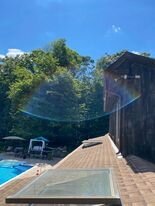I know you've been working on this a long time and you probably anxious to be done with it. However, if all else fails and you are still questioning the line of sight and the trees, here's an accurate method to determine whether your line of sight is obstructed.
Twice a year, spring and fall, for about a week, the sun and the arc of the satellite constellation are very closely aligned. This is called "sun transit". (When the satellite you are locked onto and the sun are in exact alignment with your dish, you can actually lose the signal for a few minutes. Frustrating when it happens in the middle of your programming, but it can't be helped.)
But you can use this phenomenon to your advantage for checking line of sight, even before installing your dish.
To calculate the dates/times of sun transit for your location use the calculator at
Telesat Tools.
At the time/date of sun transit given by the calculator go to your dish location and see whether the sun is obstructed in any way. If not, then you do not have a line of sight problem.
Unfortunately for your present situation, sun transit does not occur until the first week of October.
To use the calculator:
Select "Anik G1" for the satellite
Enter "Andover, MA" for your location
Select "2022" for the Prediction Year
Select "August to November" for the Prediction Season
Leave the "C/N Mode" "FDS Angle Mode" at whatever its default is
Select "X" or "ku" for the Frequency Band (either will be close enough for what you're doing)
Enter "1" for Antenna diameter
Enter "150" for System Temperature
Click Calculate
A chart will appear in the center of the screen giving the dates/times of sun transit at your location. Go to your dish site at one of the "peak transit" times listed and see if the sun is obstructed at that location. If not, you're good for line of sight.
Sorry sun transit doesn't occur in September, but I got no control over that!


